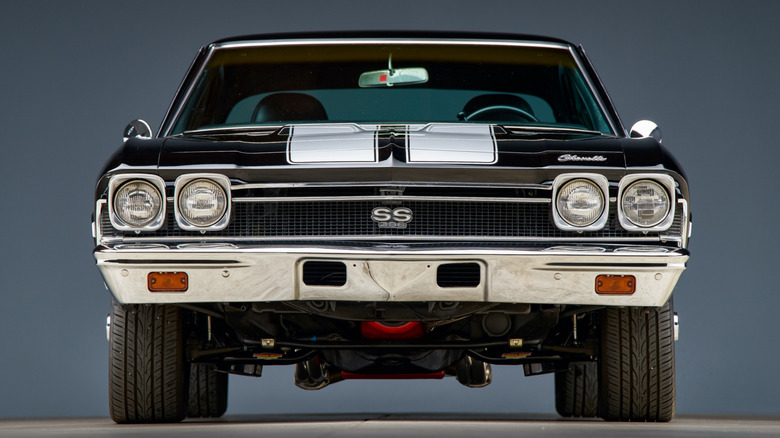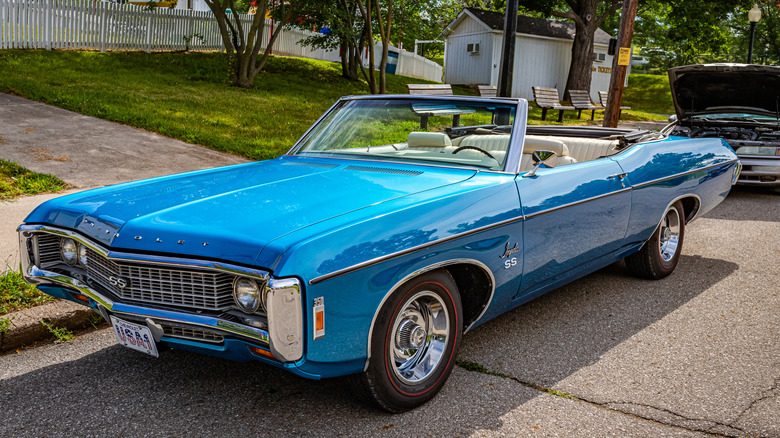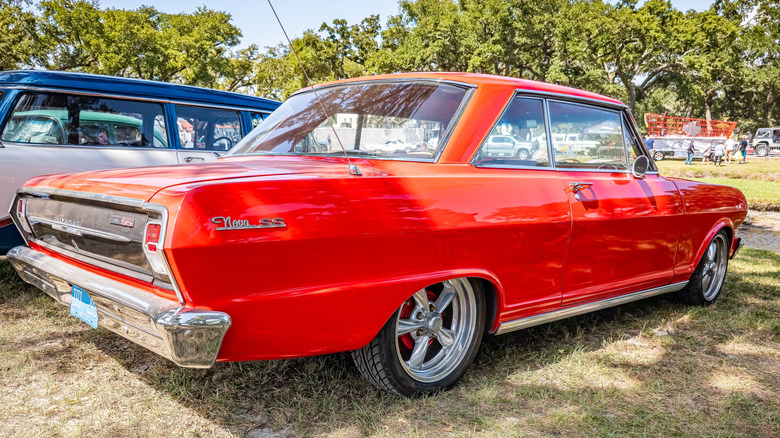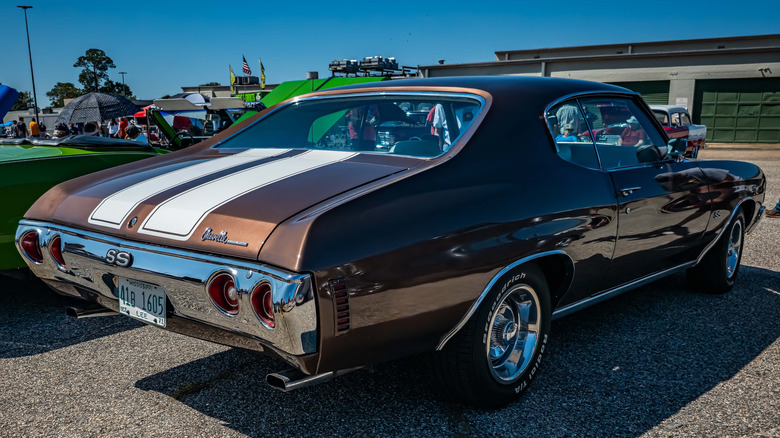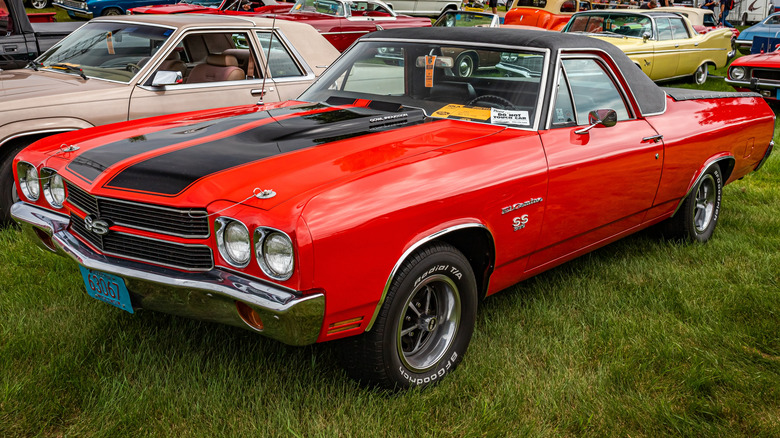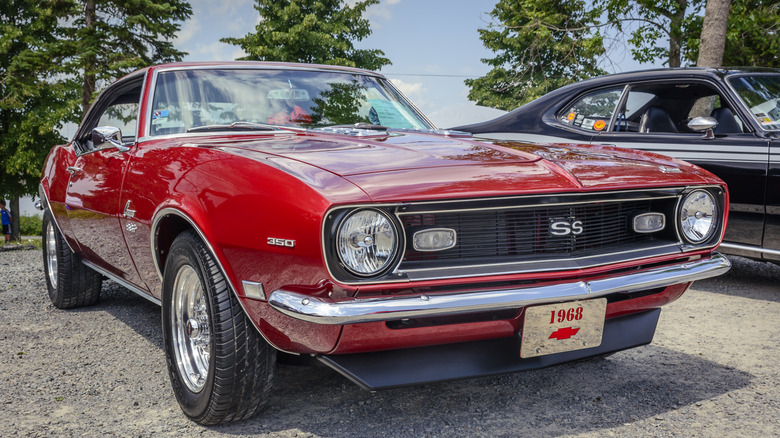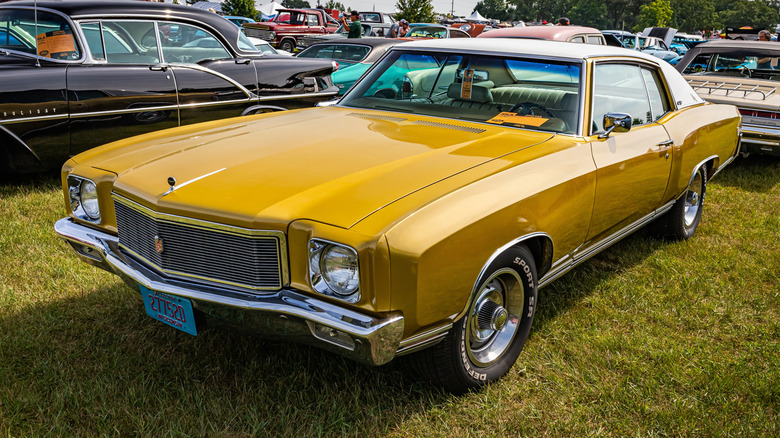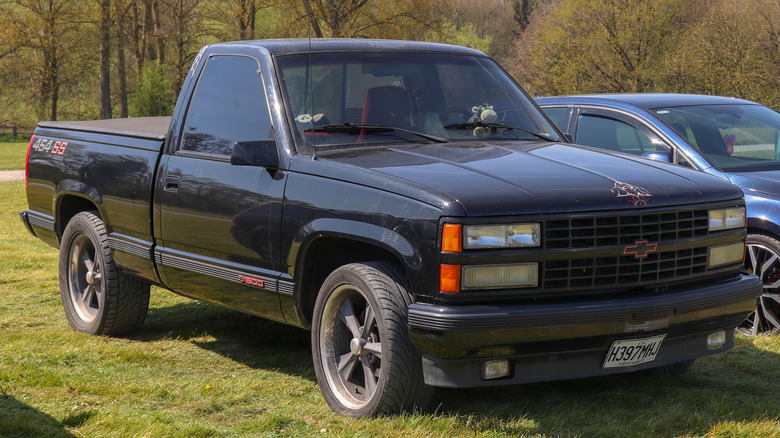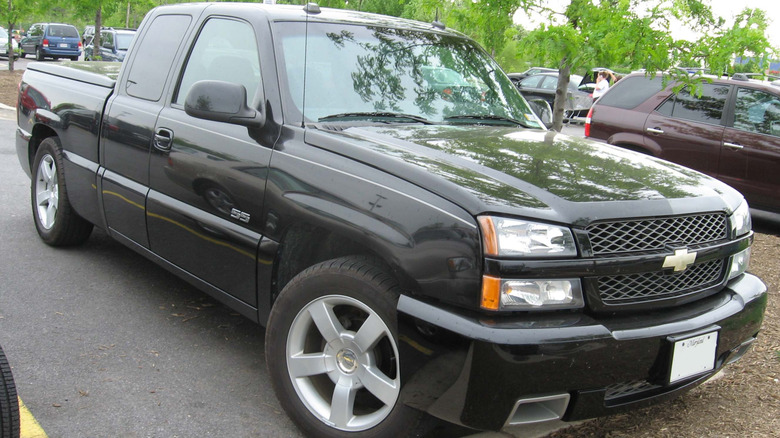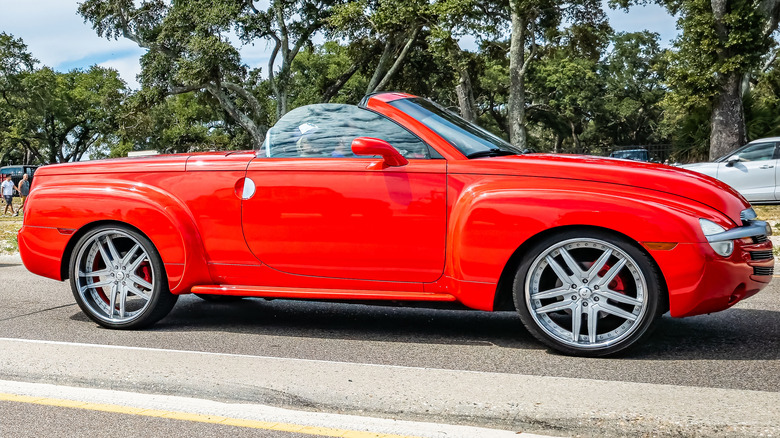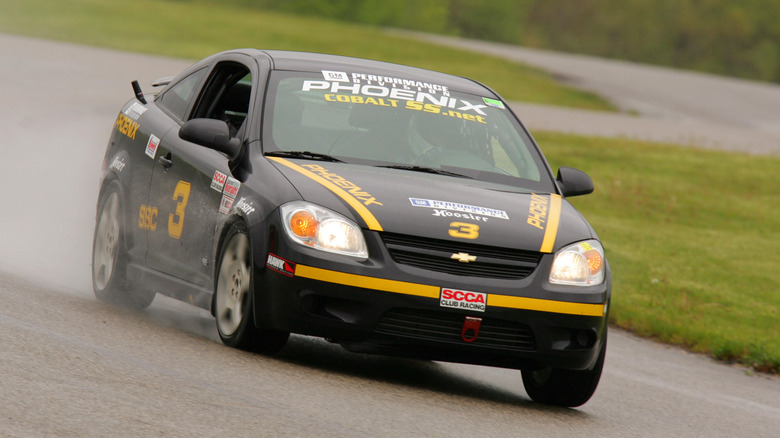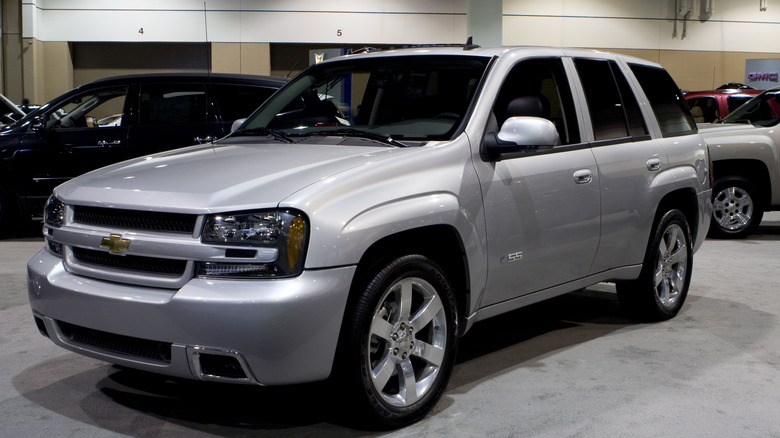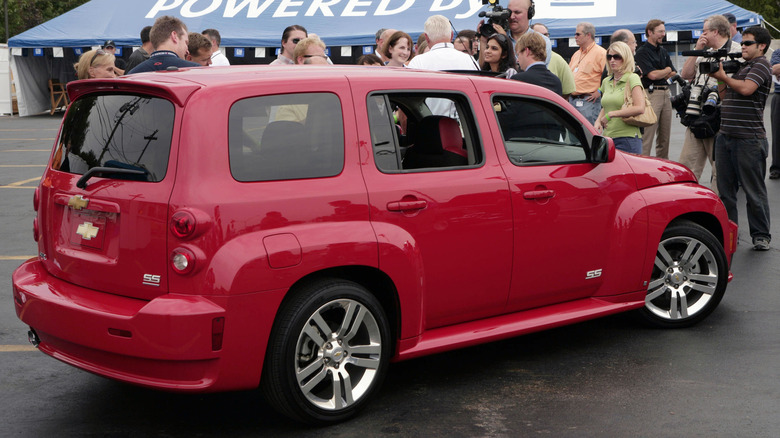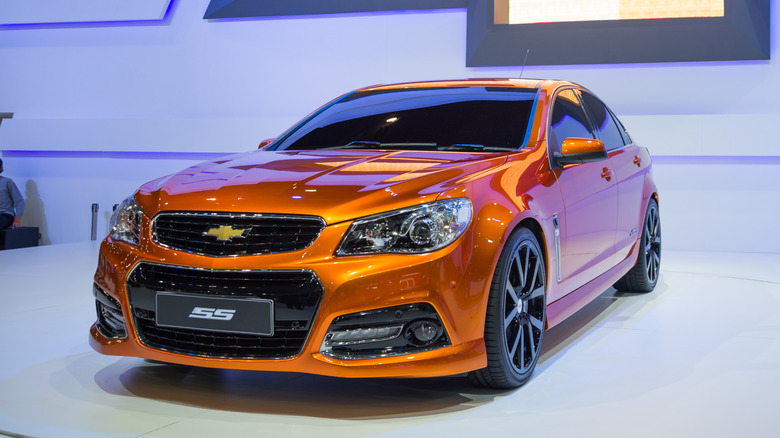Every Chevy With The SS Badge: A Long Legacy Of Performance
Chevrolet's SS moniker stands for "Super Sport," a name that appeared first on the 1956 concept car called the Corvette Super Sport. This was GM's attempt to turn the first-generation Corvette into a true factory racer, and it led to a second racing concept called the Corvette SS. With a small-block V8 and a magnesium body, the Corvette SS broke a record for a timed lap at Sebring in 1957 but failed to complete the race.
Nevertheless, a legend was born and the SS badge would be fixed to more than a dozen Chevrolet models over six decades in multiple countries. SS indicates a high-performance version of a Chevy model, often a basic coupe or sedan, given engine and suspension enhancements to turn it into a boulevard brawler. The badge has also appeared on models that were already sporty to begin with, like the Camaro, and even on SUVs and pickup trucks.
As for which current model has the badge, the 2024 Camaro Collector's Edition SS was the swan song for SS models, at least for now. There's a rumor of an electric Chevy Blazer EV SS shortly, and while something may be lost without the throaty growl of a V8, the ultra-juiced Blazer will most likely uphold the performance heritage of Super Sport models past.
Impala SS
As the first production SS model, the 1961 Chevrolet Impala SS can stake a plausible claim as the progenitor of the Golden Age of Muscle Cars. As a full-sized car, it may have been too big for many to consider it a true muscle car. It certainly stayed true to the formula of stuffing a powerful V8 in an otherwise ordinary car at an affordable price. It was very affordable, in fact: the SS kit only added $53.80 to the price of an Impala. The package also included suspension upgrades, a tachometer, and a grab bar for nervous passengers.
Impala SS buyers got a choice of three versions of Chevy's 348-cubic-inch big block V8 or a 409-cubic-inch V8, the latter of which was only available in the SS package and often referred to by collectors as the Impala SS 409. The most powerful 348 V8 was a four-barrel model producing 350 horsepower, while the 409 cranked out 360 horses. This was good for a quarter-mile run of just a tick over 14 seconds at 98 mph. The SS badge continued to grace Impalas until 1969 before being resurrected for a 260-horsepower, Caprice-based sedan in the 1990s.
Nova SS
The first Nova SS package appeared on the compact Chevy II Nova in 1963, making it the second production SS model. Both coupes and convertibles could wear the SS badge, but in 1963, it was primarily an appearance package with special wheels and tires, wider body moldings, and aluminum trim. Power came from a six-cylinder engine. However, partway through the 1964 model year, Chevy installed a 283-cubic inch small block V8 that produced 195 horsepower and a respectable 275 lb-ft of torque. Convertible production ended, and all subsequent '64 Nova SS cars were coupes.
Nova sales were never great, partly because the car found stiff competition with some of its own stable mates from Chevy, including the Chevelle and Camaro in the late '60s and early '70s. However, Nova SS production soldiered on with bigger and more powerful engines, culminating in the 1970 model with a 396-cubic-inch big block V8 that pumped out 375 horsepower. This car also featured dual exhausts, a blackout grille, performance tires, and special body trim. Nova SS production would continue until 1976, but never with the same raw power.
Chevelle Malibu SS and Chevelle SS
The Malibu started as a higher-end model of the Chevelle, and the 1964 Chevelle Malibu SS fits the muscle car formula nicely since it was a midsize car with a potent V8 under the hood. In this case, the V8 was Chevy's 283-cubic-inch V8 producing 195 horsepower. That output wasn't huge, but it could be bumped up to 220 with a four-barrel carburetor and dual exhausts. A four-speed manual gearbox offered good access to that power. Performance was respectable, with a 9.7-second 0-60 time. Hot rodders would often boost that performance with aftermarket parts.
Still, even 220 horsepower wasn't enough for the intensifying muscle car wars, so in January of 1964, Chevy released a Chevelle Malibu SS with a 327 V8 producing up to 300 horsepower. Torque was a very healthy 360 lb-ft. IT has since moved into real muscle car territory. Even more power was yet to come with a 375-horsepower, 396-cubic-inch V8 in 1965. In 1966, the Malibu SS name was dropped in favor of the Chevy SS396.
By 1969, the SS396 designation referred to an option package that could be ordered on all Chevelles, including the Malibu, and by 1970, the package was called the Chevelle SS, with a 454 V8 offered as an option. 1973 was the last year for the SS package. In 2006, Chevy revived the SS designation for a Malibu — sort of. The Malibu Maxx, an Opel-based wagon/hatchback mix, received the SS badge and a 3.9-liter, 240-horsepower V6.
El Camino SS
The SS package debuted on Chevy's El Camino car-pickup hybrid in 1968 as a standalone model called the SS-396. That year, the SS package was exclusively available with big-block engines, offering three variants of the 396-cubic-inch V8 producing 325, 350, or 375 horsepower. From 1969 onwards, the vehicle was known as the El Camino SS. In 1970, Chevrolet dropped its 454-cubic-inch big-block engine into the El Camino SS, producing up to 450 horsepower and creating the most desirable El Camino of the muscle-car era. After that year, engine sizes dropped.
The El Camino was positioned as a near-luxury personal cruiser. Bucket seats came standard, and options included then-luxurious amenities like cruise control and an AM/FM radio. Exterior cues included a blacked-out grille. After 1972, the El Camino SS disappeared for about a decade but was revived in 1983 as the result of a collaboration between Chevy and Choo Choo Customs of Chattanooga. This was primarily an appearance package with a front end resembling the era's Monte Carlo SS. Choo Choo customs continued to make them until El Camino production ended for good in 1987. Rumors abound that GM may build a 2025 El Camino, but so far, those rumors appear to be unfounded.
Camaro SS
The original generation of Camaro provided an SS-350 option with a 295-horsepower, 350-cubic-inch V8. Next, the 1970 Camaro SS marked the first Super Sport offering in the second-generation Camaro lineup. The new Camaro was lower and wider than its predecessor and came standard with an impressive 350-cubic-inch engine producing 300 horsepower. Buyers could opt for the available 396 engine, producing 350 horsepower. There were also 600 Camaro SS cars equipped with the L78 version of the 396, which was actually a 402-cubic-inch motor despite retaining the 396 name. This larger engine produced 375 horsepower and featured a 10.75:1 compression ratio. Every Camaro SS engine option generated 415 lb-ft of torque.
The SS package included distinctive features like dual exhaust, a black grille and rear valance panel, and distinctive Rally wheels. The 396 also received an upgraded suspension with a rear stabilizer bar. While the Camaro Z28 tends to get more attention from collectors, the 1970 Camaro SS has earned a respected place in the collector car market. Its combination of strong performance credentials and the second-generation Camaro's improved refinement and handling capabilities has made it particularly appealing to knowledgeable enthusiasts. This is reflected in its current market value, with SS 396 models commanding prices in the mid-$80,000 range.
Monte Carlo SS
Chevy's luxury coupe received the SS treatment starting in 1970. The Monte Carlo SS featured Chevy's 360-horsepower Turbo-Jet 454 V8 with a four-barrel carburetor. The SS package also included a heavy-duty suspension, wider tires, load-leveling rear suspension, and distinctive SS 454 badging. Paired with a three-speed automatic transmission, the Monte Carlo SS could accelerate from 0-60 mph in 7 seconds and run a quarter-mile run in under 15 seconds. The Monte Carlo SS continued into 1971.
Chevrolet reintroduced the Monte Carlo SS in 1983 as part of the fourth-generation lineup, where it remained in production through 1988. This new SS featured an aerodynamic front-end design that stood out from the square front ends of most American coupes and sedans of the time. Chevy also gave it a High Output 305-cubic-inch small-block V8, equipped with a Rochester Quadrajet four-barrel carb. This engine produced 175 horsepower and 240 lb-ft of torque.
The sixth and final generation of Monte Carlo launched in 2000, bringing back the SS badge. The initial version featured a 3.8-liter V6 producing 200 horsepower and 225 lb-ft of torque. For 2004 and 2005, Chevrolet offered a supercharged version of this engine, boosting output to 240 horsepower and 280 lb-ft of torque. The final Monte Carlo SS's most powerful engine arrived for its last two years of production in 2006 and 2007, a 5.3-liter V8 generating 303 horsepower.
454 SS
Pickup trucks got the 454 treatment for the first time as the '90s dawned, with a big block 454 V8 hinting at the coming revival of the muscle car ethic. Chevrolet's 454 SS truck made 230 horsepower in its initial 1990 model year, a fairly modest amount, but it was complemented by a more respectable 385 lb-ft of torque. An automatic transmission channeled power to the rear wheels; four-wheel-drive was not available. Initially, the truck came only in monochromatic black, complete with a black grille and trim. A large "454 SS" graphic adorned each side of the pickup bed. Despite its fairly modest horsepower, its gutsy torque could push the 454 SS from 0 to 60 mph in about eight seconds.
1991 saw the 454 SS get the new Gen V engine with 255 horsepower and a very healthy 400 lb-ft of torque. A new four-speed automatic and a 4.10 gear ratio helped to harness the extra power. From 1991 on, the 454 SS sported dual exhaust pipes. In 1992 and 1993, the truck could be purchased in white, red, or black. Bucket seats and a center console gave the interior the look of a sports car.
Silverado SS
Chevy again extended the Super Sport philosophy to pickup trucks from 2003 to 2007 with the Silverado SS and Silverado Intimidator SS, the latter named for the late Dale Earnhardt. To make its most powerful pickup of the day, Chevy dropped a 6.0-liter LQ9 V8 into the engine bay of a Silverado 1500, giving the truck 345 horsepower and 380 lb-ft of torque. A four-speed automatic delivered that power to all four wheels during the model's first two years on the market, but beginning in 2005, a rear-wheel-drive version was available. Starting in 2006, RWD was the only drivetrain layout available.
The Silverado SS rode an inch lower in front and two inches lower in back compared to a regular Silverado. It rode on a high-performance chassis with a sport suspension, giving it performance in more than just a straight line. Skidpad grip equaled 0.74g — not exactly a sports car level of handling, but not at all shabby for a pickup. This agility complemented a 6.3-second 0-60 time to make the Silverado SS a legitimate choice for driving enthusiasts who may have needed to tow over 8,000 pounds on occasion.
SSR
It would be redundant for this El Camino-like vehicle to have an SS trim since the name SSR stands for Super Sport Roadster, so the "SS" is built right in. Produced from 2003 through 2006, the SSR can accurately be described as a bold gamble by Chevy. Its combination of bulging, retro-looking fenders and modern aerodynamics polarized opinions from the outset, and you could argue that the Chevy SSR was a failure. But perhaps its oddest feature was the fact that this truck was also a roadster. That's right: it had a retractable hardtop. It's safe to say there was nothing else like it on the road before, nor has there been since.
The SSR was truly a truck rather than a car with a truck body since it shared a platform with the Trailblazer. Therefore, like the Trailblazer, it was hefty to the tune of 4,760 pounds. Given that, its 5.3-liter, 300-horsepower V8 was slightly overwhelmed. Straight-line performance wasn't fantastic, although big brakes and a beefed-up suspension with anti-roll bars gave it some control over the curves. Plus, of course, its owners had an actual pickup truck bed for hauling gear. If you drive one, you absolutely will not see another vehicle on the road like yours unless you pass someone driving one of the very few other SSRs that were ever built.
Cobalt SS
One of the smallest models in Chevy's history made an outsized impression when given the SS treatment. The Cobalt SS was fast and special, and it's still admired and desired by compact performance car enthusiasts a decade and a half after its production run ended in 2010. When Car and Driver first got some time in the driver's seat ahead of the 2005 Cobalt SS's launch, it pronounced the car "astoundingly good." They were clearly surprised that Chevy had taken a fairly unremarkable commuter car platform and found a way to make it breathe fire.
That fire initially came from a supercharged 2.0-liter four-cylinder that pumped out 205 horsepower and 200 lb-ft of torque. This potent four-banger propelled the Cobalt SS from 0-60 mph in around six seconds, which in the mid-2000s decade was serious performance for a $22,000 compact runabout. Emissions regulations eventually forced Chevy to replace the supercharged engine with a 2.0-liter turbo four in 2008, but horsepower and torque both improved to 260 each, shaving about a half second off the 0-60 time. One year earlier, a naturally aspirated 2.4-liter four-cylinder Cobalt SS had been released, offering 173 horsepower. The 2.4-liter was renamed the Cobalt Sport when the turbo Cobalt SS became available.
Trailblazer SS
A full-sized SUV may seem like an unlikely platform for a Super Sport model, but with 395 horsepower on tap, the Trailblazer SS lived up to the badge's legacy. From 2006 through 2009, the Trailblazer SS delivered power in spades with a 6.0-liter LS2 V8 borrowed from the Corvette, good for 395 horsepower and 400 lb-ft of torque. MotorWeek observed a 0-60 time of 5.8 seconds, which becomes even more impressive when you realize that the Trailblazer SS weighed 4,875 pounds.
To give the big truck handling to match its power, Chevy installed a lowered and stiffened suspension that it called "Road Course Tuned." This setup included Bilstein dampers and an air-leveling system for the rear axle. Drivers wouldn't mistake the Trailblazer SS for a Ferrari in the curves, but this was a big upgrade in handling over most vehicles with its bulk. Buyers could choose between rear-wheel-drive or all-wheel-drive. Despite the performance enhancements, it could still tow 6,700 pounds while offering tons of interior room for passengers and cargo.
HHR SS
The HHR ("Heritage High Roof") was already a retro throwback with a style that recalled the 1949 Suburban, so perhaps making an SS version was a natural step. On the other hand, the regular HHR had a reputation as a sedate grocery-getter. That's what the Super Sport tradition is all about: taking an everyday car (or truck, or SUV) and turning it into something fun. In this case, the fun came from a turbocharged 2.3-liter four-cylinder cranking out 260 eager horsepower. It also added nifty features like launch control to make that power easier to unleash. A no-lift shift feature allowed drivers to keep the gas pedal on the floor while shifting the manual transmission without hitting the redline.
The result was a 0-60 time of just over six seconds, which was great for getting those groceries home in a hurry. With lower ground clearance and lightweight 18-inch wheels, handling was improved over regular HHRs. Stabilitrak boosted grip on slippery surfaces or during hard acceleration. Torque steer was nearly absent, which was quite an achievement for Chevy's engineers in a powerful front-wheel-drive vehicle. The HHR SS was built from 2008 through 2011.
Chevrolet SS
Perhaps it's fitting that one of the final SS models built (for now) is simply called the SS. This car came from a land down under, and car enthusiasts could hear the thunder: from 2014 to 2017, Chevy brought the Australian Holden Commodore SS to the States to create this modern-day classic. Its collectability is boosted by the fact that the Chevy SS is rare, with only 12,924 units made. Rare, handsome, and very fast – leave it to the country that brought us "Mad Max" to hit the trifecta of automotive awesomeness.
The SS's thunder came from a 6.2-liter, 415-horsepower engine driving the rear wheels through either a six-speed manual or six-speed automatic transmission. Car and Driver recorded a 0-60 run of only 4.6 seconds, with a quarter-mile time of 13 seconds flat. With front struts, a multilink rear suspension, Magnetic Ride Control (from 2015 on), and big, sticky tires, the SS could handle well, too. It posted a 0.97 g skidpad result in Car and Driver's test, a number once reserved for Corvettes and Italian supercars.
At a starting price of $44,470, it offered autobahn-quality performance at a noticeably lower price than most German sports sedans. If no other SS models ever get built, this one is a fitting tribute to the Super Sports heritage.
